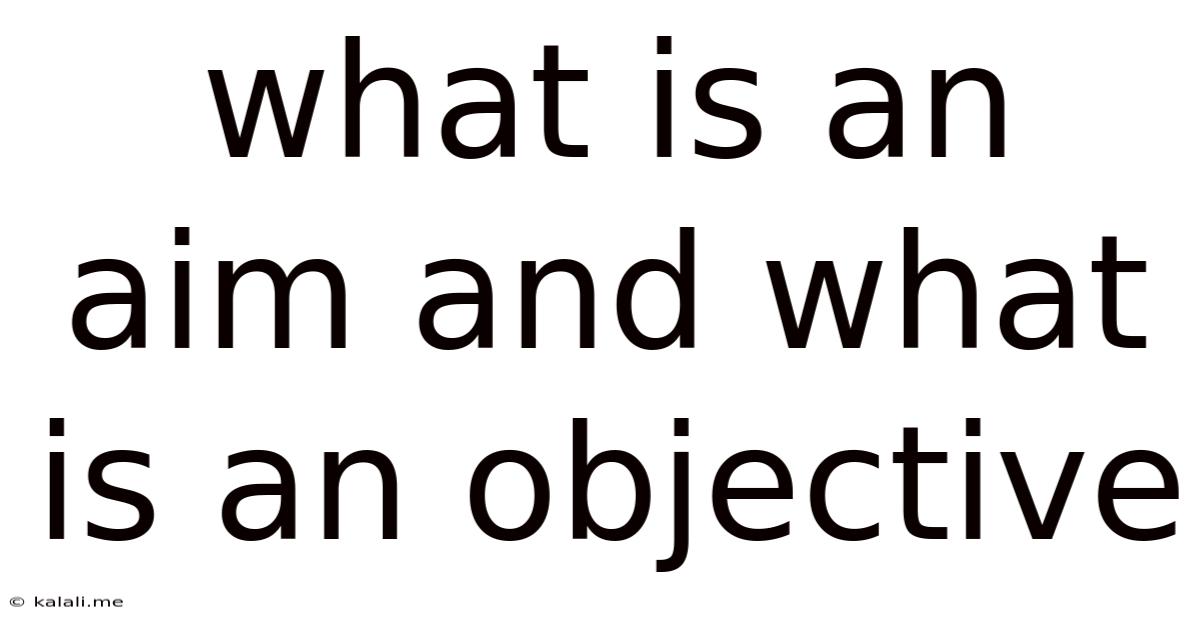What Is An Aim And What Is An Objective
Kalali
Jun 11, 2025 · 3 min read

Table of Contents
What is an Aim and What is an Objective? Understanding the Difference
Understanding the difference between an aim and an objective is crucial for effective planning and goal setting, whether you're crafting a business strategy, a personal development plan, or even just tackling a complex project. While often used interchangeably, aims and objectives have distinct characteristics that influence their impact on achieving desired outcomes. This article will clarify the distinctions, providing practical examples to solidify your understanding.
What is an Aim?
An aim is a broad, long-term goal that describes the overall intention or desired outcome. It's the aspirational statement that sets the direction for your efforts. Aims are typically less specific and measurable than objectives, serving as a guiding principle rather than a concrete milestone. Think of it as the ultimate vision you're striving for.
-
Characteristics of an Aim:
- General and overarching: Aims are not highly detailed or specific.
- Long-term focus: They represent a distant destination rather than immediate steps.
- Qualitative rather than quantitative: They are often expressed using descriptive language rather than numerical targets.
- Inspirational and motivational: Aims provide a sense of purpose and direction.
-
Example: "To become a leading provider of sustainable energy solutions." This aim is broad and leaves room for various strategies and actions to be implemented.
What is an Objective?
An objective is a specific, measurable, achievable, relevant, and time-bound (SMART) step that contributes directly to achieving an aim. Objectives are the concrete actions and milestones you need to accomplish to reach your ultimate aim. They provide a roadmap with clear markers of progress.
-
Characteristics of an Objective:
- Specific and clearly defined: Objectives leave no room for ambiguity.
- Measurable and quantifiable: Progress towards objectives can be tracked and evaluated.
- Achievable and realistic: Objectives should be challenging yet attainable.
- Relevant and aligned with the aim: Objectives should directly support the overall aim.
- Time-bound with deadlines: Objectives have clear deadlines to ensure accountability.
-
Example: "To increase market share by 15% in the renewable energy sector within the next two years." This objective is specific, measurable, achievable, relevant to the aim, and time-bound.
The Relationship Between Aims and Objectives:
Aims and objectives are intrinsically linked. Aims provide the overarching vision, while objectives define the specific steps required to achieve that vision. Objectives are the building blocks that pave the path towards realizing the aim. Without well-defined objectives, an aim remains just an aspiration, lacking a clear path to realization.
Examples Illustrating the Relationship:
Let's consider a personal aim: "To improve my physical fitness."
- Possible Objectives:
- Run a 5k race within six months.
- Lose 10 pounds in three months.
- Attend yoga classes three times a week for a year.
- Increase strength by lifting 20% more weight in four months.
In Conclusion:
While both aims and objectives are essential components of successful planning, understanding their distinct roles is crucial. Aims provide the inspiring vision, while objectives offer the concrete roadmap to get there. By clearly defining both your aims and objectives, you set yourself up for greater clarity, increased accountability, and a significantly higher chance of achieving your desired outcomes. Remember the SMART framework when defining your objectives to ensure they are effective and measurable.
Latest Posts
Latest Posts
-
How Much Oz In A Bottle Of Water
Jul 01, 2025
-
How Long Does It Take To Drive 10 Miles
Jul 01, 2025
-
How Many 9s Are In A Deck Of Cards
Jul 01, 2025
-
How Many Pounds Are In 2 5 Kg
Jul 01, 2025
-
Which Is Greater 2 3 Or 2 4
Jul 01, 2025
Related Post
Thank you for visiting our website which covers about What Is An Aim And What Is An Objective . We hope the information provided has been useful to you. Feel free to contact us if you have any questions or need further assistance. See you next time and don't miss to bookmark.